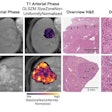Using MRI, neuroscientists at Georgetown University Medical Center found significant differences in brain anatomy when comparing men and women with dyslexia with male and female nondyslexic control groups, suggesting the disorder may manifest differently in men and women.
The study, published online April 27 in the journal Brain Structure and Function, evaluated 118 participants, comparing the brain structure of people with and without dyslexia. The researchers conducted separate analyses in men, women, boys, and girls.
Less gray-matter volume was found in dyslexic males in areas of the brain that process language. Among dyslexic females, less gray-matter volume was found in areas involved in sensory and motor processing.
The results suggest that dyslexia should be approached differently in each gender to address questions about its origin and potential treatment, according to senior author Guinevere Eden, PhD, director of the Center for the Study of Learning at Georgetown.



.fFmgij6Hin.png?auto=compress%2Cformat&fit=crop&h=100&q=70&w=100)




.fFmgij6Hin.png?auto=compress%2Cformat&fit=crop&h=167&q=70&w=250)











